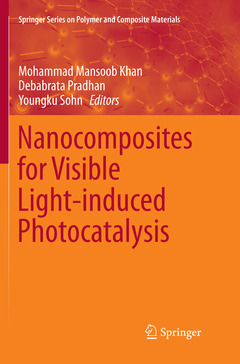Nanocomposites for Visible Light-induced Photocatalysis, 1st ed. 2017 Springer Series on Polymer and Composite Materials Series
Coordonnateurs : Khan Mohammad Mansoob, Pradhan Debabrata, Sohn Youngku

Dr. Youngku Sohn is an Associate Professor in the Department of Chemistry at Chungnam National University in South Korea. He received his PhD from the University of British Columbia in Canada in 2004. Afterwards he spent some time as postdoctoral researcher at the same university, before moving to the University of Texas in Austin (USA) in 2005 and then to the University of Waterloo, Canada in 2007. From 2008 to 2017 he held a faculty position at Yeungam University. Since 2017 he has a position as Associate Professor at
Describes different types of nanocomposites, such as metal nanocomposites and mixed metal-oxide nanoparticles, nanoporous nanocomposite materials, polymer and carbon-based nanocomposites
Offers a concisely structured and systematic overview for newcomers to a developing field
Provides the fundamentals as well as an outlook on applications, future perspectives and challenges
Includes supplementary material: sn.pub/extras
Date de parution : 08-2018
Ouvrage de 400 p.
15.5x23.5 cm
Disponible chez l'éditeur (délai d'approvisionnement : 15 jours).
Prix indicatif 158,24 €
Ajouter au panierDate de parution : 09-2017
Ouvrage de 400 p.
15.5x23.5 cm
Disponible chez l'éditeur (délai d'approvisionnement : 15 jours).
Prix indicatif 158,24 €
Ajouter au panierThème de Nanocomposites for Visible Light-induced Photocatalysis :
Mots-clés :
Visible light photocatalysis; Photoactive nanocomposites; Heterogeneous catalysis; Environmental remediation; Self-cleaning window panes; Porous nanocomposite materials; Metal nanoparticles; Surface plasmon activity; Mixed metal-oxides nanocomposites; Carbon-based nanocomposites; Polymer based nanocomposites; water quality and water pollution
